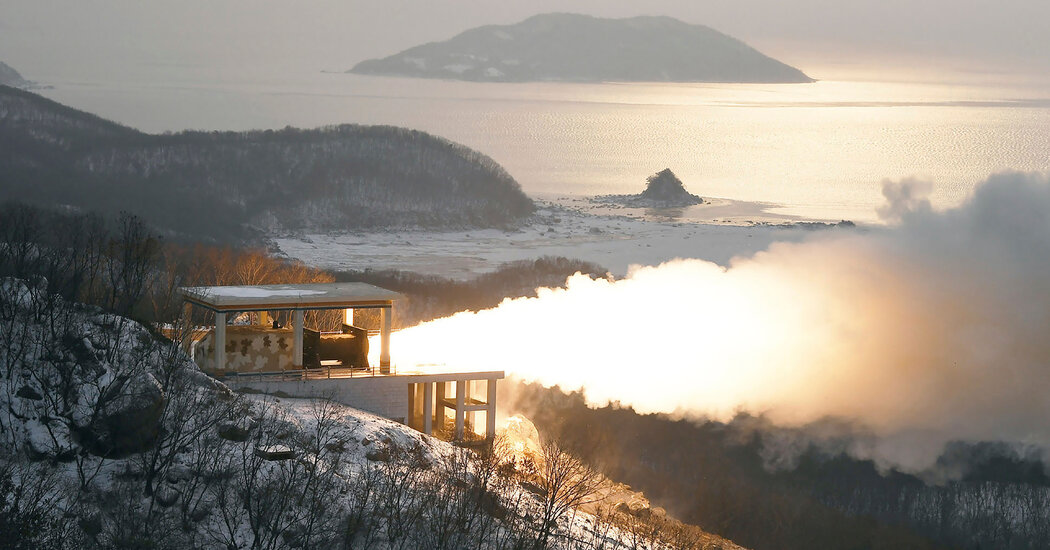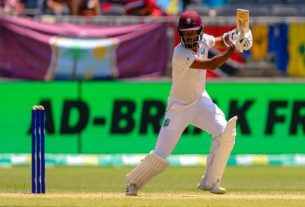SEOUL — North Korea said on Friday that it had successfully tested a powerful new missile engine this week, indicating that the country was working to build a solid-fuel intercontinental ballistic missile, a new weapon that its leader, Kim Jong-un, wanted to add to his growing nuclear arsenal.
With Mr. Kim watching, engineers from North Korea’s Academy of Defense Science conducted a ground test of a “high-thrust solid-fuel motor” on Thursday at the Sohae Satellite Launching Ground, in Tongchang-ri, in northwestern North Korea, the country’s official Korean Central News Agency reported on Friday.
“This important test has provided a sure scientific-technological guarantee for the development of another new-type strategic weapon system,” the news agency said in its English dispatch. The agency released photos that it said showed the engine, “the first of its kind in the country,” being tested in a horizontal position.
North Korea said the test confirmed the engine’s capabilities, including its thrust power. But like most technical claims by the North, the report on Friday could not be independently verified.
All three ICBMs North Korea has tested so far — Hwasong-14, Hwasong-15 and Hwasong-17 — use liquid propellants, which missile experts said make them easier for the United States and its allies to target for pre-emptive strikes because it takes hours to load liquid fuel onto missiles before they are launched. Under Mr. Kim, the country has been trying to convert its missiles from liquid to solid fuel, which would make them easier to hide and transport, and quicker to launch.
North Korea’s Missile Tests
A series of new short-range ballistic missiles North Korea has tested in recent years used solid fuel. But the announcement on Friday was the first time North Korea claimed to have successfully tested a large solid-fuel engine that could be used for an ICBM. When Mr. Kim announced his ambitious arms buildup program during a ruling Workers’ Party congress in early 2021, it included developing solid-fuel ICBMs.
North Korea said its new missile engine could produce 140 tons of thrust. If the claim is true, it is “an ICBM-class engine,” said Kim Dong-yub, a North Korean weapons expert at the University of North Korean Studies in Seoul. The North’s Hwasong-15 ICBM, which the country said was capable of reaching all of the continental United States, uses a liquid-fuel booster engine that can produce 160 tons of thrust, according to missile experts.
The United States and its allies closely watch activities at the Sohae facilities, which North Korea said were built to launch satellites. The country last launched a satellite from there in February 2016. North Korea has also used the site to test engines for its ballistic missiles. A series of resolutions by the United Nations Security Council bans North Korea from conducting any test of technologies that can be used to make ballistic missiles.
North Korea has tested new rocket engines in Sohae before test-launching new missiles, including the intermediate-range and long-range ballistic missiles that it tested in 2017.
Following the last of those tests in 2017, Mr. Kim declared a halt on all nuclear and ICBM tests and embarked on diplomacy with President Donald J. Trump. Mr. Kim and Mr. Trump met three times, but their negotiations fell apart in 2019 when they could not agree on how to roll back the North’s nuclear weapons program or when to lift sanctions imposed on the country.
Mr. Trump once boasted that Mr. Kim had promised to dismantle the Sohae facilities as one of the first steps toward denuclearization. North Korea started to dismantle some of the facilities, but when the talks with Mr. Trump stalled, it began rebuilding them and resumed missile tests. It conducted tests of a new missile engine there in 2019. This year, it resumed testing ICBMs, including the Hwasong-17, its biggest liquid-fuel long-range missile.



